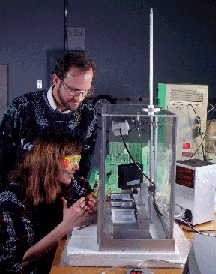Seeking A Clue Of Flu
 With a simple color change from blue to red, two
materials created by LBL researchers signal the presence of influenza, offering
the possibility of a quick nasal or throat swab test for viral infection.
With a simple color change from blue to red, two
materials created by LBL researchers signal the presence of influenza, offering
the possibility of a quick nasal or throat swab test for viral infection.
Both materials are based on flu-binding molecules developed by the
researchers. In one, the molecules are assembled into a thin film; in the
other, they are formed into microscopic spheres known as liposomes.
Materials scientist Deborah Charych developed the technologies with LBL chemist
Jon Nagy, U.C. Berkeley graduate student Wayne Spevak, and former LBL scientist
Mark Bednarski, who initiated the research. The work is part of an ongoing
research program to tailor materials for detecting pathogens, environmental
toxins, and other targets of interest.

The tests are a significant
advance in the field of biosensor research, where scientists have generally
relied on elaborate combinations of antibodies, or electronic and optical
instrumentation to measure biological substances. "Simple virus detection with
the materials requires little or no instrumentation," Charych says. "You just
look for a color change from blue to red."
The molecule that is the
basis for the materials has a composite structure, where one part of the
molecule binds the virus and the other serves as a structural backbone. The
virus-binding element is the cell surface sugar, called sialic acid, that
serves as an attachment site on human cells for flu viruses. The sialic acid is
connected to a diacetylene lipid, a molecule similar to the phospholipids that
are the building blocks for cell membranes.
The molecules can be made to
assemble into thin films on surfaces or into free liposomes in solution.
Exposure to UV light activates a triple bond within the diacetylene lipids,
creating stable, blue-tinted films or liposomes which are covered with sialic
acid sugars.
Potentially infected samples are dropped onto the surface
of the film or into the liposome solution, and virus present binds to the
sialic acid sugars. Virus binding changes the structure of the interconnected
lipid chains beneath the sugars, and causes the molecules to absorb a different
wavelength of light, i.e. change color from blue to red.
The amount of color change depends on how much flu virus is present in a sample; lower
concentrations of virus generate only an intermediate purple color. Researchers
can estimate the amount of virus in a sample by reading the films or liposomes
with a colorimeter.
"We think we can detect the virus at levels lower than what you see in a
full-blown flu case," Charych says. "The next step is
obtaining throat or nasal swab samples from flu patients to show that these
could be easy tests to use in the field or in a doctor's office."
The researchers are also working to understand the molecular mechanisms of the
color change, and to apply the sensor technology to other environmental
agents.
-- Mike Wooldridge
 With a simple color change from blue to red, two
materials created by LBL researchers signal the presence of influenza, offering
the possibility of a quick nasal or throat swab test for viral infection.
With a simple color change from blue to red, two
materials created by LBL researchers signal the presence of influenza, offering
the possibility of a quick nasal or throat swab test for viral infection.

 Return to Highlights Table of Contents
Return to Highlights Table of Contents